 |
 The Happy Daylily Blog - daylily pictures and thoughts from my garden
The Happy Daylily Blog - daylily pictures and thoughts from my garden

|
 March 31st, 2017 March 31st, 2017 |
As I sat in the shade to rest a bit and enjoy the day, a bee flying in the garden caught my eye. The previous day there had been a single daylily bloom and I removed the spent bloom first thing that morning. It appeared that the bee was looking for that bloom.
Surrounding where the bloom had been, there were 3 white flags marking daylilies from last season that had not been moved to the evaluation bed. The bee would first hover looking at one flag, then move to the second flag and after looking at it for a couple of seconds, go and look at the third flag. Then it would fly about 10 feet away before immediately flying back to where the bloom had been. It then repeated the same exact sequence of looking at each of the 3 flags before flying off again. It was like the bee was thinking "I know the bloom is here somewhere..." (smile).
I sat and watched this bee do the same thing over and over again. The only variance was a couple of times when another bee came too close and was chased away. The bee then returned to his bizarre behavior. After a half hour, I went in and had some lunch. Twenty minutes later I came back to the garden to find the bee still going through the same ritual. Even after 50 minutes the bee had not given up. I don't know how much longer this kept on because I had work to do but it sure was a strange sight.
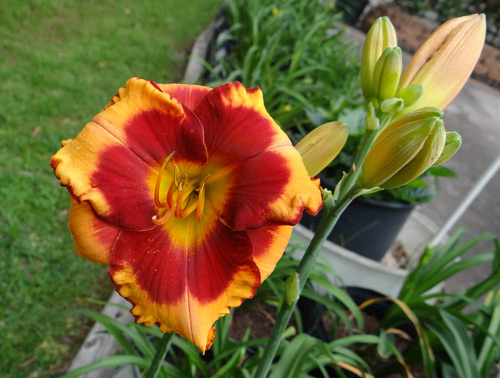
Seedling 15-013
Seedling 15-013 is the first seedling in the evaluation bed to bloom this season.
|
 March 30th, 2017 March 30th, 2017 |
I am a proponent of maintaining a healthy soil food web to maximize plant health. If you are not familiar with the importance of the soil food web, information can be found on another of my sites Hemerocallis, The Daylily. Under 'Growing Daylilies', click 'Healthy Soil - the key to great daylilies'.
Digging or otherwise disturbing the soil disrupts the food web and in the past few months I have dug, divided, or otherwise moved most of my daylilies. The food web disruption can be only temporary but I like to do whatever I can to hasten its reestablishment. So I purchased a gallon of "Garrett Juice Pro" and today I applied it to all the daylilies that had been disturbed over the past few months.
Garrett Juice Pro was originally recommended to me by a fellow daylily grower and hybridizer. It is a concentrate that contains Humic Acid, Beneficial Soil Microbes, Mycorrhizae, Hydrolized Fish, Liquid Seaweed, Molasses, and Apple Cider Vinegar. It provides a boost to the soil food web which results in healthier plants.
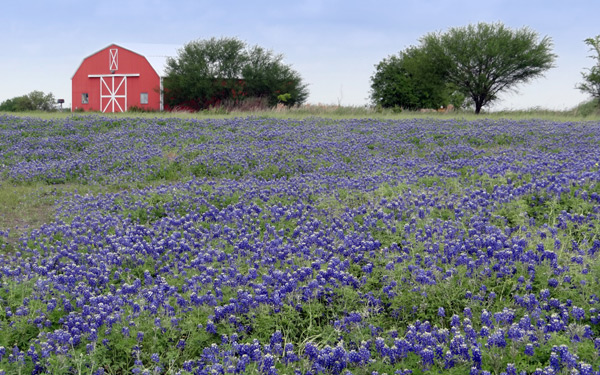
Texas Bluebonnets
The Bluebonnet is the Texas state flower and every year they can be found growing along many of Texas' highways about this time of year. I heard that they were really nice this year so earlier this week we took a drive to Chappell Hill, Texas to see for ourselves. This is one of the pictures from our trip.
|
 March 24th, 2017 March 24th, 2017 |
Before I go out and 'putter around the garden' this morning, I thought I'd post an image of Flamingo Wings (Jarvis 2014). It has 7.5" blooms on up to 40" scapes so it stands out quite well in the garden. This is another cultivar that will be in my upcoming yard sale.

Flaming Wings
|
 March 23rd, 2017 March 23rd, 2017 |
Yesterday I finished removing the non-selected seedlings from the oldest seedling bed. Even after trimming the foliage, I still filled a huge box to be given away. The box was so heavy I couldn't lift it and had to drag it into a shady spot. Today, my yard guy took them away. He plants them around his property as both he and his wife really enjoy them. He has even shown me pictures!
I've also been busy taking inventory for our club's annual daylily sale. I wanted to get this finished today and entered in a spreadsheet so I could give it to the plant sale chairman at the club meeting tonight.
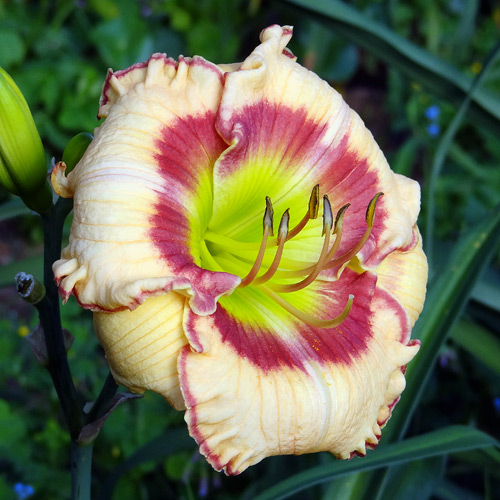
Second new seedling to bloom this year
This is a picture of the second new seedling to bloom this year. It's a pretty face but I haven't decided if I will mark it or not because the bud count is a little lower than I like. This year I'll have limited space in the evaluation beds so I'll have to be more selective in what seedlings get flagged.
|
 March 18th, 2017 March 18th, 2017 |
I finally finished most the major daylily projects. The front yard beds have been reworked and the daylilies have been planted and mulched. Most of the over 150 7-gal pots have had the soil ammended and the daylilies replanted. About all that's left is to clean out the oldest seedling bed. There's nothing of interest left in the bed as I've either selected or given away any that were decent. The bed will be decommissioned and having one less bed to take care of will lighten the workload.
Another seedling bloomed for the first time this morning. It was better than the one a couple of weeks ago but not good enough to mark for evaluation. Still, it was nice to have a daylily to look at while I was weeding this morning. Too many scapes are now showing to count. Bloom season is right around the corner.
Because I recently dug up everything except the new seedling bed I'm not expecting too much when it comes to blooms this year. Typically, the first year after digging/dividing blooms are smaller and bud counts are lower. The new seedling bed is looking pretty good however and that's where most of the current scapes are.
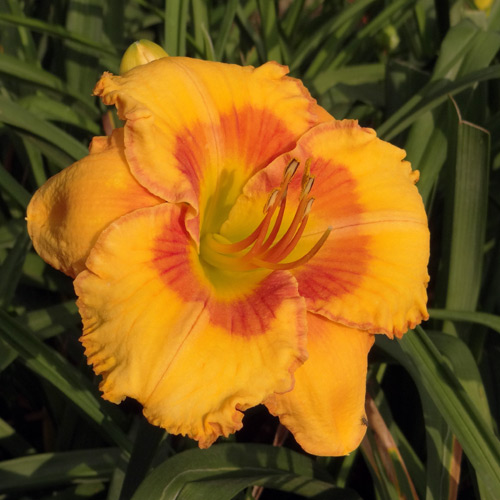
Bella Vita
Today's image is Bella Vita (Jarvis 2011). It has 6" blooms on 30" scapes. Bella Vita means "Good Life" in Italian.
|
 March 14th, 2017 March 14th, 2017 |
The daylily foliage is looking real good right now - nice and clean and green. The spring rust season is due shortly and not wanting to let it get a foothold, I made a pre-emptive strike and sprayed some Cleary's 336F. This is one of the fungicides that has shown to be effective in controlling rust. I'm hoping I can keep it under control this year. Daylily rust cannot be eliminated but it can be controlled with regular spraying with selected fungicides. Spraying every 7-10 days is recommended for optimum control. The problem I've had in the past has been finding the proper weather conditions for spraying within the 7-10 day window. Spraying is a waste of time if rain is expected and it's not recommended to spray when the wind is blowing. Now that the local weather is forecasting 7 days in advance it is becoming easier to plan in advance when I'll be able to spray.
While spraying I discovered that I have more scapes than I posted yesterday. There are probably a couple of dozen now with a couple that may bloom within a week or so.
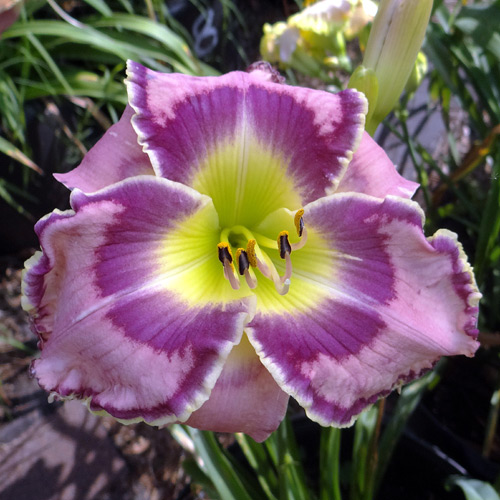
Panama City
Here's a picture of Panama City (Trimmer 2009), another cultivar that will be in my April yard sale. It has 6.75" blooms on 32" scapes.
|
 March 13th, 2017 March 13th, 2017 |
It definitely appears that bloom season will start early this year. I recently saw a website that estimated the Houston area to be about 20 days ahead of schedule. While working in the garden today I counted about 15 scapes in my seedlings. What makes this especially unusual is that I don't use any early bloomers in my hybridizing program. I much prefer mid-season bloomers as they perform the best in this zone.
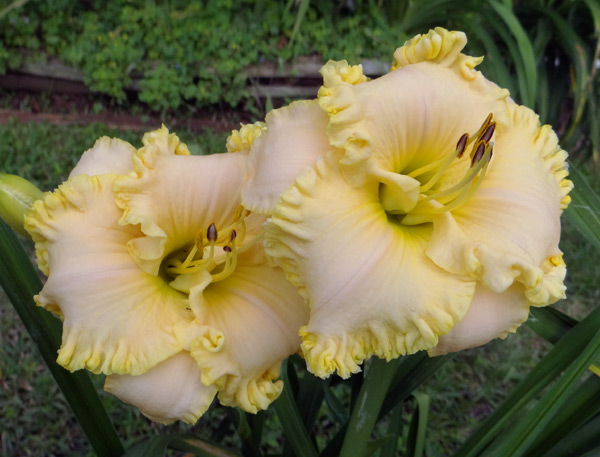
Celtic Moonglow
Continuing with registered cultivar pics, this is Celtic Moonglow (Jarvis 2014). It has 6.5" blooms on 30" scapes and will also be available in my April yard sale.
|
 March 11th, 2017 March 11th, 2017 |
I spread some of the second batch of mulch yesterday. I still have quite a bit more to distribute but the humidity was quite high which makes it difficult for me to work more than a few hours. We're supposed to have several cool days next week so that will give me a chance to finish the project.
A lot of changes have been made over the course of the winter. Cultivars have been removed to be sold in my annual yard sale, poor performing seedlings have been discarded, pretty but average performing seedlings have been removed and given away, and selected seedlings from last season's first bloom bed have been moved to the evaluation beds. In addition, many plants have been moved due to the complete revamping of the front yard. All the changes had to be made in my database to keep it current. I finished making these changes this morning.
Keeping garden information in a database works well for me but isn't necessarily the way to go for everyone. Some keep their garden info in a spreadsheet or even handwritten in a notebook. There are even some whose mind is like a steel trap that keep everything in their heads. My mind is becoming more like a sieve every day so I need to keep records (smile).
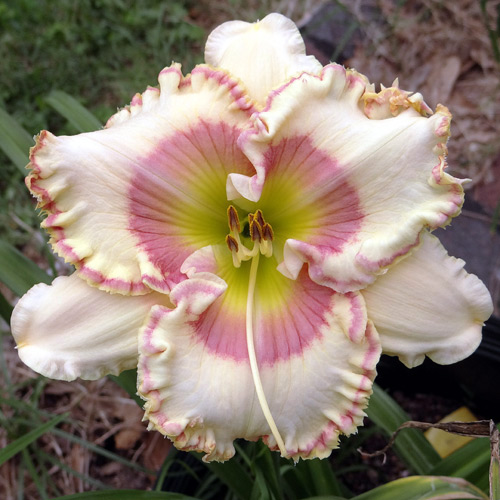
Barbie's Favorite
I thought I'd post some named cultivar pictures from 2016 before the new season gets underway. This is BARBIE'S FAVORITE (Smith-F.R. 2008). It has 6" blooms on nice tall 36" scapes. This will be available in my yard sale on April 22nd.
|
 March 7th, 2017 March 7th, 2017 |
There was an 80% chance of rain today so I decided to stay inside and make garden markers. I like to place a garden marker with each daylily containing the name of the daylily or seedling to identify it. I originally did this because I was told it was 'the thing to do'. That was fine with me because I have a compulsion for organization (at least with some things).
Some people keep a garden map instead of investing in garden markers. The markers can be a little pricey depending on how fancy or well made they are. With some daylily gardens having hundreds of different cultivars the cost to mark each one can mount up to a pretty penny. The markers I use are at the low end of the scale. They are not fancy but serve the purpose quite well. They have aluminum inserts where the name can be posted making it relatively inexpensive to reuse the marker for a new cultivar as the garden evolves. The company that made these has since closed its doors so they are no longer available.
I use a Brother P-Touch labeler to print the names for the markers. The tape I use is white background with black letters. It has an adhesive backing that when applied to a clean smooth surface (like the aluminum inserts) lasts almost indefinitely. Even more surprising is the weather resistance of the labels. They can go years without any appreciable fading even in Houston's hot summer sun. Of course I can't make any claims regarding how they stand up in extended cold with snow and ice. That never happens here (smile).
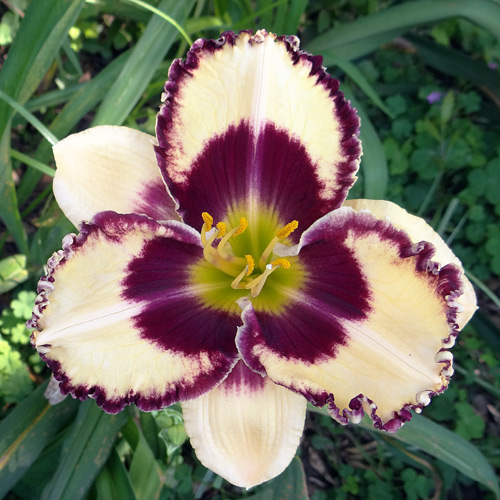
Seedling 14-023
Today's seedling is 14-023. It has a decent size bloom (6.5") but the scapes are only 20". Years ago that height was considered just fine but my own preference has always been for taller scapes, especially with a 6.5" bloom.
|
 March 4th, 2017 March 4th, 2017 |
Yesterday I started spreading the new mulch. The mulch gives the garden a finished look but that's only the beginning. The mulch I use is made from aged and ground native hardwoods. Because it's made from hardwoods, it can last through an entire season even in my hot, moist climate.
The finer particles settle to the soil surface when it rains. These appear to make a fine food for earthworms as the soil is full of them in the fall. The larger particles provide moisture retention and protection from the hot summer sun. The only down side is that I have to drive about 30 miles each way to get the mulch and my 17 year old Toyota pickup can only handle a half yard at a time. Needing only a couple of yards each year makes having it delivered way too expensive.
Today I finished spreading the first yard. Next week I'll go get another yard so I can finish the job.
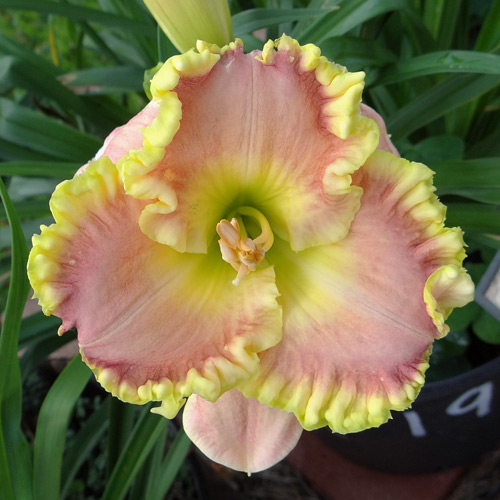
Seedling 13-078
Seedling 13-078 is a pretty face that doesn't have much else going for it. The plants were small and so was the bud count. After giving it three years to improve to no avail, I sent it bye-bye this past fall. Sometimes a hybridizer has to be rutheless, even with pretty faces.
|
 March 1st, 2017 March 1st, 2017 |
Today I decided that I would put down the mulch before I bring in the stone for the edging. Every day I postpone mulching means another day that weeds can grow in the unmulched bed.
I also decided to give the daylilies in the two new beds a little boost by applying some Osmocote fertilizer before I apply the mulch. I'm doing this because the soil food web has not had a chance to establish. I applied it on top of the ground around each cultivar. Osmocote is a time-release fertilizer so it should provide small amounts of nutrients over a period of a few months.
In addition to the Osmocote, I also scattered a handful of alfalfa pellets on the soil surface around each cultivar. The addition of alfalfa pellets to the soil stimulates vigorous growth. This is primarily from the nitrogen made available as the alfalfa breaks down but there are also growth hormones and important trace elements present in the alfalfa. Caution should be used using alfalfa as a soil amendment because it can give off a fair amount of heat as it breaks down. For this reason I only work alfalfa into the soil during the fall or winter when soil temperatures are cooler and can dissapate the extra heat. The rest of the year I spread it on the soil surface.
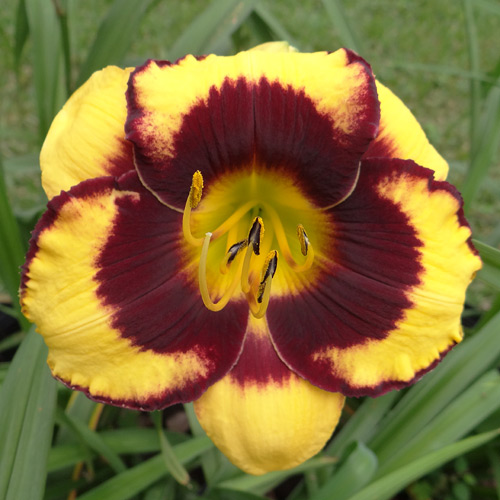
Seedling 15-024
Today's seedling is 15-024. It has 5" blooms on 29" scapes. It comes from the cross HEDWIG'S EYES x DRAGON KNIFE.
|
 February 25th, 2017 February 25th, 2017 |
This morning I put out the last daylilies in the front beds using the submerged double pot method I discussed in yesterday's post. It's nice to see the front yard full of daylilies again. Several of the beds have been empty since last fall. Next, I need to bring in some stone for edging. Once all that's done I'll be ready to put down the hardwood mulch.
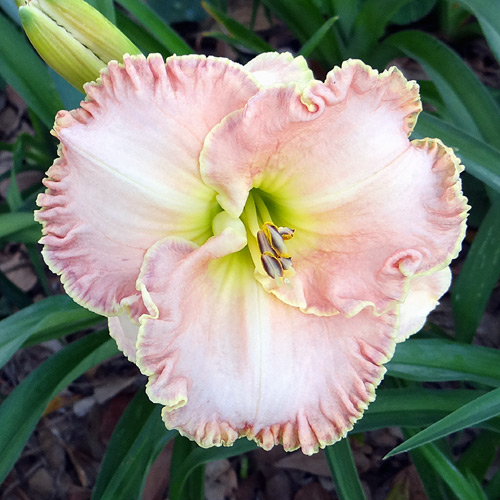
First Seedling of 2017
This is a picture of the first seedling to bloom this year. I really don't like the color, something between a peach and parchment. I decided to post the picture anyway as some people do like this color and as a record of the unusually early bloom date. This is actually the third bloom on the scape. The first two tried to open when temperatures were in the low 40's and they never opened properly.
|
 February 24th, 2017 February 24th, 2017 |
I've always had a small amount of nut grass growing in my front yard beds but last year it was unbelievable. I had dozens of shoots per square foot. At first I thought I had brought it in with the hardwood mulch but investigation showed that the problem has been lurking dormant in my beds all along. The mulch improved the growing conditions for it just like it did for the daylilies and the dormant nut population exploded. There are herbicides that kill nut grass but unfortunately they also kill daylilies so spraying was not an option. I pulled out all the shoots several times but they came right back because the nuts are deep in the soil.
So last fall I removed all the daylilies planting them in 2-gallon pots. I then sprayed an herbicide recommended to kill the nut grass. I did kill some of it but being late in the season, it was already starting to go dormant and I suspected that most of the effort was a waste of time. A little digging this spring confirmed my suspicions. There's a robust network of nuts in the top 8 inches or so just waiting for the weather to get hot enought to trigger it to start growing again.
I really need to spray the nut grass during the summer when it's actively growing and that means there can't be daylilies in the beds when I spray. Not wanting to have empty beds for the entire summer, I've come up with a plan. All the daylilies that need to go back into these beds are currently growing in 2-gallon pots. I have placed an empty 2-gallon pot submerged about 3/4 deep where each daylily should be planted. The pots with the daylilies are then placed in the submerged pots. This double pot system allows me to easily remove the potted daylilies leaving the empty submerged pot. Once all the daylilies have been removed, I'll be able to spray to kill the nut grass. After 24 hours I'll place the daylily pots back into the submerged pots. Hopefully I can eliminate the nut grass with a series of herbicide applications. Once it's been eradicated I can then plant the daylilies back in the soil. I'll update how this worked out probably in the fall.
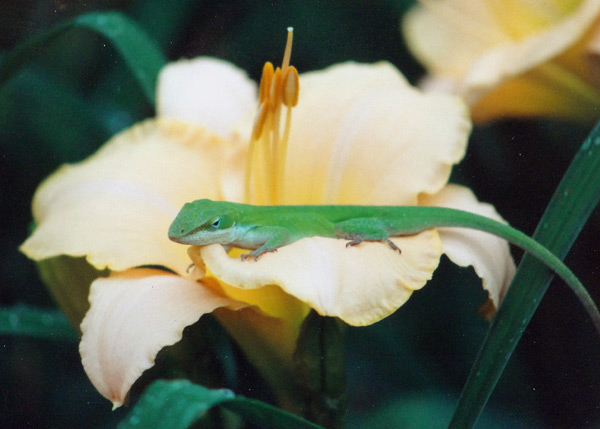
Ming Porcelain
I was looking back through my picture archives and I came across this image. It was taken about 20 years ago but I've always liked it. I even have a framed enlarged copy hanging on my office wall. The daylily is an old favorite, MING PORCELAIN. The lizard is a Green Anole which is very common in this area. They even occasionally find their way into the house which of course doesn't make my wife very happy (smile). Last week one came in and after checking out the kitchen and under the appliances, I opened the door and it ran back outside.
|
 February 16th, 2017 February 16th, 2017 |
I had my first bloom for 2017 today which is the earliest bloom I've ever had. It was in the new seedling bed and no I'm not posting a picture. It was 41 F. this morning and it barely opened which was probably a good thing as it was an ugly color.
For those considering hybridizing, be aware that not all seedlings are potential future Stout Medal winners. The following is an estimate of what results you might get in a typical batch of seedlings where moderately decent parent plants were used:
- The worst 2.5% are absolute dogs suitable for the compost heap.
- The next 13.5% are a little better but may suffer from poor bloom color, poor form, very low bud count, poor growing habits, or other serious flaws. I also compost these.
- The next 34% are what I would call "decent garden plants". The blooms may be attractive enough but not special and the plants are only average to mediocre performers. If you know someone who just can't understand why you would discard any daylily, they may be happy to get these. For some reason I have always had such a person and they look forward to getting these every year when I clean out my seedling beds.
- The next 34% are what I call "nice garden plants". They are of good enough quality that they would be appreciated by the average gardener but probably not good enough to register. I typically give these away to friends and family members.
- The next 13.5% are the "keepers". I would consider a seedling to be in this group if it was good enough for further evaluation based on bloom beauty, bud count, and plant performance. Only a few of these will eventually be considered good enough to register but I may continue to grow some of the others simply because I enjoy their beauty.
- The last 2.5% are the "super stars". These are the seedlings that have something that sets them above most other seedlings. Usually it's a special bloom and good performance. It should also not have any major flaws.
This is my own evaluation scale based on my hobby hybridizing. A commercial hybridizer could have a totally different way of looking at his results. The top hybridizers probably consider the best 3-5% as worthy of registration and compost everything else unless they're using it in their hybridizing program.
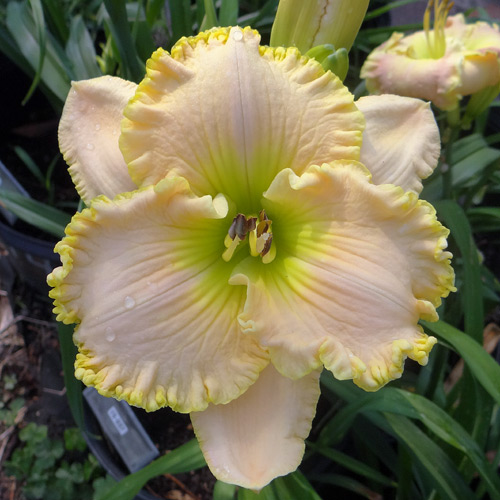
Seedling 15-037
Today's seeding image is 15-037. Every daylily enthusiast has their preferences for daylily form and color and this is definitely one of my favorites. I like the pink-blushed cream color with the intense green throat. It is a very consistent bloomer. It comes from the cross MAY I HAVE THIS DANCE x HOG HEAVEN. I posted a yellow daylily from this same cross a couple of days ago and it's interesting to see the different colors that came from the same cross.
|
Previous Posts
 Back to current posts
Back to current posts
|

 March 31st, 2017
March 31st, 2017 March 30th, 2017
March 30th, 2017 March 24th, 2017
March 24th, 2017 March 23rd, 2017
March 23rd, 2017 March 18th, 2017
March 18th, 2017 March 14th, 2017
March 14th, 2017 March 13th, 2017
March 13th, 2017 March 11th, 2017
March 11th, 2017 March 7th, 2017
March 7th, 2017 March 4th, 2017
March 4th, 2017 March 1st, 2017
March 1st, 2017 February 25th, 2017
February 25th, 2017 February 24th, 2017
February 24th, 2017 February 16th, 2017
February 16th, 2017 Back to current posts
Back to current posts












